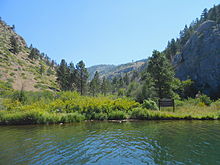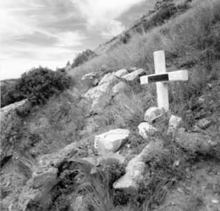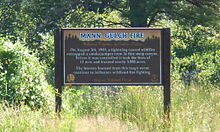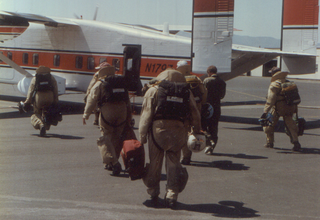
Smokejumpers are specially trained wildland firefighters who provide an initial attack response on remote wildfires. They are inserted at the site of the fire by parachute. This allows firefighters to access remote fires in their early stages without needing to hike long distances carrying equipment and supplies. Traditional terrestrial crews can use only what they can carry and often require hours and days to reach fire on foot. The benefits of smokejumping include the speed at which firefighters can reach a burn site, the broad range of fires a single crew can reach by aircraft, and the larger equipment payloads that can be delivered to a fire compared to pedestrian crews.

The Great Fire of 1910 was a wildfire in the Inland Northwest region of the United States that in the summer of 1910 burned three million acres in North Idaho and Western Montana, with extensions into Eastern Washington and Southeast British Columbia. The area burned included large parts of the Bitterroot, Cabinet, Clearwater, Coeur d'Alene, Flathead, Kaniksu, Kootenai, Lewis and Clark, Lolo, and St. Joe national forests.The fire burned over two days on the weekend of August 20–21, after strong winds caused numerous smaller fires to combine into a firestorm of unprecedented size. It killed 87 people, mostly firefighters, destroyed numerous manmade structures, including several entire towns, and burned more than three million acres of forest with an estimated billion dollars' worth of timber lost. It is believed to be the largest, although not the deadliest, forest fire in U.S. history.
An escape fire is a fire lit to clear an area of vegetation in the face of an approaching wildfire when no escape exists. Approximately 40-percent of all wildfire deaths are caused by such fire entrapments, or what are sometimes called "burnovers".
John Norman Maclean is a journalist and author who has written five books on fatal wildland fires and a memoir, Home Waters: A Chronicle of Family and a River.
He is the son of Norman Maclean, author of A River Runs Through It and Young Men and Fire, and grandson of the minister John Norman Maclean.
Fire on the Mountain (ISBN 0061829617) is a 1999 non-fiction book by John N. Maclean that describes the most famous wildland fire of the late 20th century. The book describes the events and aftermath of the South Canyon Fire on Storm King Mountain on July 6, 1994, in Colorado, which took the lives of 14 firefighters. Those who died included nine members of the Prineville (Oregon) Hotshots: Kathi Beck, Tami Bickett, Scott Blecha, Levi Brinkley, Doug Dunbar, Terri Hagen, Bonnie Holtby, Rob Johnson, and Jon Kelso, along with a Missoula Smokejumper, Don Mackey, two McCall (Idaho) Smokejumpers, Roger Roth and James Thrash, and two members of a Helitack crew, Richard Tyler and Rob Browning. Fire on the Mountain, won the Mountain and Plains Booksellers award as the best non-fiction book of 1999. It was made into an eponymous two-hour documentary by the History Channel that was a finalist for an Emmy award and won the Cine Master's Award as the best documentary of 1999.

Helena National Forest is located in west-central Montana, in the United States. Covering 984,558 acres (3,984.36 km2), the forest is broken into several separate sections. The eastern regions are dominated by the Big Belt Mountains, and are the location of the Gates of the Mountains Wilderness, which remains much as it did when the Lewis and Clark Expedition passed through the region. The western sections have both the continental divide and the Scapegoat Wilderness area, which is part of the Bob Marshall Wilderness complex. The southern region includes the Elkhorn Mountains. The forest is composed of a mixture of grass and sagebrush covered lowlands with "island" pockets of lodgepole pine and more mountainous areas where Douglas fir, spruce and larch can be found. The rocky mountains in the region do not exceed 10,000 feet.

The Gates of the Mountains Wilderness is located in the U.S. state of Montana. Created by an act of Congress in 1964, the wilderness is managed by Helena National Forest. A day use campground near the Gates of the Mountains, Meriwether Picnic site, is named in honor of Meriwether Lewis.

In the United States, a Shot Crew, officially known as an Interagency Hotshot Crew (IHC), is a team of 20-22 elite wildland firefighters that mainly respond to large, high-priority fires across the country and abroad. They are assigned to work the most challenging parts of the fire and are considered strategic and tactical wildland fire experts. Hotshot crews are considered the most highly trained, skilled and experienced wildland firefighters, along with smokejumpers. They are qualified to provide leadership for initial-attack and extended-attack on wildland fires. Hotshots are trained and equipped to work in remote areas for extended periods of time with minimal logistical support. They are organized by agencies such as the United States Forest Service, National Park Service, Bureau of Indian Affairs, Bureau of Land Management, and state/county agencies; the National Interagency Fire Center coordinates hotshot crews on the federal level.

Young Men and Fire is a 1992 non-fiction book written by Norman Maclean. It is Maclean's story of his quest to understand the Mann Gulch fire of 1949 and how it led to the deaths of 13 wildland firefighters, 12 of them members of the USFS Smokejumpers. The fire occurred in Mann Gulch in Montana's Gates of the Mountains Wilderness on August 5. The book was a national bestseller and won the 1992 National Book Critics Circle Award for general non-fiction.
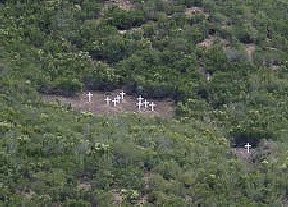
The Rattlesnake Fire was a wildfire started by an arsonist on July 9, 1953, in Powder House Canyon on the Mendocino National Forest in northern California. The wildfire killed one Forest Service employee and 14 volunteer firefighters from the New Tribes Mission, and burned over 1,300 acres (530 ha) before it was controlled on July 11, 1953. It became and remains to this day a well-known firefighting textbook case on fatal wildland fires.

Red Skies of Montana is a 1952 American adventure drama film directed by Joseph M. Newman and starring Richard Widmark, Constance Smith and Jeffrey Hunter. Widmark stars as a smokejumper who attempts to save his crew while being overrun by a forest fire, not only to preserve their lives, but to redeem himself after being the only survivor of a previous disaster.

The South Canyon Fire was a 1994 wildfire that took the lives of 14 wildland firefighters on Storm King Mountain, near Glenwood Springs, Colorado, on July 6, 1994. It is often also referred to as the "Storm King" fire.
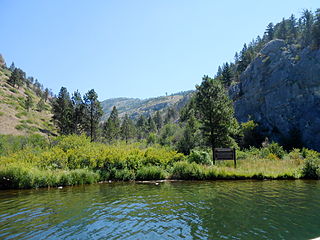
Mann Gulch is a gulch in the Gates of the Mountains Wilderness of the upper Missouri River, 24 miles (39 km) north-northeast of Helena, Montana, in southeastern Lewis and Clark County. It is on the east side of the Missouri River and approximately 9 miles (14 km) east of Interstate 15 (I-15), between Helena and Wolf Creek. Mann Gulch is between Meriwether Canyon immediately to the south and Rescue Gulch immediately to the north, and the creek it contains flows into the Missouri in the canyon known as the Gates of the Mountains. Mann Gulch is approximately 2.4 miles (3.9 km) southeast of Beartooth Mountain.
Harry Thomas Gisborne was an American forester who pioneered the scientific study of wildfires.

The Federal Building, U.S. Post Office and Courthouse, Missoula, Montana, is a building housing various services of the United States federal government. Built between 1911 and 1913, an expansion initiated in 1927 and completed in 1929 allowed the building to serve thereafter as a courthouse of the United States District Court for the District of Montana. The building was again expanded in the 1930s, and was listed in the National Register of Historic Places in 1979.
Earl Cooley (1911–2009) spent his career working in the U.S. Forest Service (USFS), where he was concerned with developing new methods of fighting forest fires. In 1940, he was one of the first U.S. firefighters to parachute from a plane onto a wildfire. Cooley went on to train others to fight fires by smokejumping. After his retirement from the USFS, he set up the National Smokejumper Association, of which he was president from 1993 to 1995.

The National Smokejumper Association (NSA) is a non-profit, American organization based in Missoula, Montana, that preserves the history of aerial fire management, or smokejumping, through interviews, rosters, photographs, films, letters, reports and publications. It is also a meeting area for people involved with wildland firefighting and helps in the preservation of national forests and grasslands. The first president of the NSA was Earl Cooley, one of the first smokejumpers for the United States Forest Service. Cooley presided over the NSA from 1993 to 1995. Other past presidents of the NSA were Laird Robinson, Ed Courtney, Carl Gidlund, Larry Lufkin, Ron Stoleson and Doug Houston. The current president is Robert A. McKean.
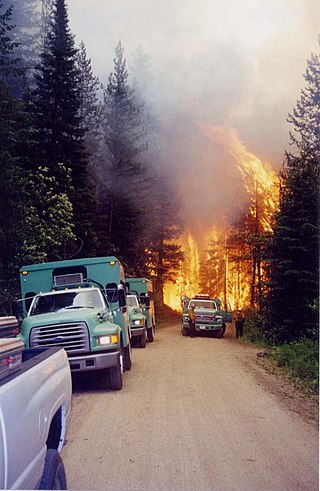
The Thirtymile Fire was first reported on July 9, 2001 in the Okanogan National Forest, approximately 30 miles (48 km) north of Winthrop, Washington, United States. The wildfire had been caused by an unattended campfire that spread rapidly in the hot and dry weather in the Pacific Northwest. Four firefighters were killed when the fire cut off their only escape route out of the narrow canyon.

On August 18, 1937, a lightning strike started the Blackwater Fire in Shoshone National Forest, approximately 35 miles (56 km) west of Cody, Wyoming, United States. Fifteen firefighters were killed by the forest fire when a dry weather front caused the winds to suddenly increase and change direction. The fire quickly spread into dense forest, creating spot fires that trapped some of the firefighters in a firestorm. Nine firefighters died during the fire and six more died shortly thereafter from severe burns and respiratory complications. Another 38 firefighters were injured. The fire killed more professional wildland firefighters in the U.S. than any other in the 103 years between the Great Fire of 1910 and the Yarnell Hill Fire in 2013.

The Mann Gulch fire was a wildfire reported on August 5, 1949, in a gulch located along the upper Missouri River in the Gates of the Mountains Wilderness, Helena National Forest, in the state of Montana in the United States. A team of 15 US Forest Service smokejumpers parachuted into the area on the afternoon of August 5, 1949, to fight a 50-60 acre lightning-caused blaze, assisted by a local recreation guard. As the team approached the fire, an unexpected change in wind direction caused the fire to ignite heavy fuels, creating a "blowup" and cutting off the men's escape route to the Missouri River. The crew was forced to retreat uphill into a lightly timbered area with a dense groundcover of extremely flammable grass and brush. The fire moved rapidly up the slope, burning 3,000 acres (1,200 ha) in ten minutes and claiming the lives of 13 firefighters, including 12 of the smokejumpers. Only three of the smokejumpers survived. The fire would continue for five more days before being controlled.



